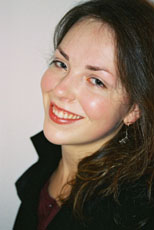A blank sheet of paper that starts wrinkling when a few drops of water are sprinkled over its surface and form some kind of pattern or contour - this is the image that has been recently haunting the imagination of Justė Janulytė whose music is driven by the need to embody in sound her most utopian ideas, fantasies and impressions. "I like the idea that those 'drops' form each time different patterns, which acquire different meanings, though these differences are very slight and subtle", she explains. "They are so minute that I couldn't render them in striking musical gestures, virtuosic eloquence or varicoloured palette of different timbres; so I mostly write for ensembles of uniform instruments and prefer to keep their individual sounding in monochrome as much as possible, which is enough to express the rugosity of wrinkled paper." This may sound a bit toned down, but in reality it helps bring forth the sonorities of captivating beauty, remarkable consistency and astonishing changeability.
|

photo: Gintarė Minelgaitė
|
Justė Janulytė (b. 1982) first came into public view as the youngest Lithuanian composer to win the nomination of the year's best chamber composition in 2004 for her
white music. Written as a graduation piece for 15 strings, it was inspired by Alessandro Baricco's idea that every story has its own music (which is how he described his novel
Silk). "The music of
Silk is white", he said. Since white is an achromatic mixture of seven basic colours of the visible spectrum, the modal colour of Janulytė's white music is composed of seven different heptatonic scales, which are being constantly mixed, layered and merged until they blend completely to form 'white diatonic'. It is on this 'blank' harmonic canvas that the fragile lacework of white music begins its slow metamorphosis from silently sliding glissandos, dripping pizzicatos and gently rippling trills in the beginning to many-layered textures, with occasionally surfacing lyrical motifs, flows and ebbs of 7 micro-ensembles that build up in static polychords and gradually vanish into thin air at the end.
In all of her distinctly intimate and introspective pieces Janulytė carefully moulds the overall form, swarming with tiny, hardly perceptible musical events. Generally very soft, slow and arhythmic music ends up completely differently from what it was in the beginning. But this transformation can barely be felt, and is identified only after it has been accomplished. When timbres, harmonies and rhythms are subdued, textures, gradations of volume and extended playing techniques become the keywords for her music. "I have a certain phobia of one-layer, one-track music. What I try to do is to mix different substances, like 'paper' and 'water', to take different gradations of volume, overlapping textures and gradually transforming scales, and combine them in several layers thereby creating illusory or even fictitious sonorities." In her recent piece for string quartet,
if Paper could dream it would dream of Water, premiered last spring at Milan Conservatory where she spent a training period, there is perhaps no single moment where all four players would meet on the same dynamic level or use the same playing technique. The spaciousness and many-layeredness of her earlier piece for two pianos,
music of apple trees in blossom (2003), was even more enhanced by performing its version for piano (Alfonso Alberti) and live electronics in the "I concerti nel chiostro" series at Milan's Puccini Hall in July this year.
Her most recent piece,
Endings, written for Quasar Saxophone Quartet of Montréal as a commission from the Gaida Festival, is intended to evoke the effect of a four-voiced saxophone, shimmering with four slightly different timbres. Completely void of rests, it is full of breathing in separate sounds, melodies and harmonies that are gradually moving upwards within the range of one octave (which is the only one where the diapasons of all four saxophones coincide). This octave becomes a 'blank paper' onto which four different endings of one story are written without actually telling what this story was all about. Janulytė: "I was interested in the aesthetic and rhetoric of endings. For example, when you read endings of novels, in most cases they tell no more stories, just convey the atmosphere of the stories already told. In my piece I used attacks and sounds without attacks, which reminded me of one acoustic experiment when meanings of words were changed or destroyed completely by cutting off the initial consonants. This way I tried to make my music 'speak' without timbres and meanings." However, this is no end to the ineffable story told by Justė Janulytė's new piece: after being premiered at the Gaida Festival in October,
Endings will receive its Canadian premiere at the Chapelle historique du bon pasteur in Montréal performed by Quasar Saxophone Quartet on November 19.
© Veronika Janatjeva
Lithuanian Music Link No. 11

